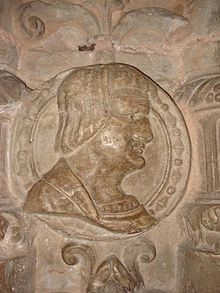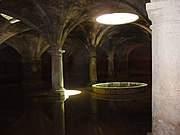João de Castilho
- View a machine-translated version of the Portuguese article.
- Machine translation, like DeepL or Google Translate, is a useful starting point for translations, but translators must revise errors as necessary and confirm that the translation is accurate, rather than simply copy-pasting machine-translated text into the English Wikipedia.
- Do not translate text that appears unreliable or low-quality. If possible, verify the text with references provided in the foreign-language article.
- You must provide copyright attribution in the edit summary accompanying your translation by providing an interlanguage link to the source of your translation. A model attribution edit summary is
Content in this edit is translated from the existing Portuguese Wikipedia article at [[:pt:João de Castilho]]; see its history for attribution. - You may also add the template
{{Translated|pt|João de Castilho}}to the talk page. - For more guidance, see Wikipedia:Translation.
João de Castilho | |
|---|---|
 | |
| Born | 1470 |
| Died | 1552 (aged 81–82) |
| Nationality | Portuguese |
| Other names | Juan de Castillo |
| Known for | Architecture |
| Notable work | World Heritage Buildings |
| Movement | Renaissance |
João de Castilho (1470–1552), also known as Juan de Castillo (Merindad de Trasmiera, Cantabria, c. 1470 — c. 1552), was a Castilian and a notable Iberian architect born in Castillo Siete Villas, actually Arnuero (Cantabria). He is recognisably one of the premier architects in Portuguese history (where he developed most of his work), responsible for several World Heritage buildings. He was a Spanish-Portuguese master builder and architect originally from Cantabria (former Kingdom of Castile; present-day Spain), who developed his mature career in Portugal, where he settled in c.1508. He is considered the greatest Portuguese architect of the 16th century and one of the greatest in Renaissance Europe.
Trained in the gothic style, his activity made its mark during the Manueline period, after which he played a decisive role in affirming the Renaissance style in Portugal. João de Castilho was one of the major protagonists of a decise shift towards classicism. His career also highlights the gradual promotion of the position of master mason (medieval) to that of architect – in the modern sense of the word – with the corresponding recognition and rise in social status.
Author of a vast and notable body of built work, João de Castilho is linked to the building of five historic monuments classified by UNESCO as World Heritage, two great highlights being the Jerónimos Monastery and the Convent of Christ. Among many other works for which he was responsible, he also contributed to the Alcobaça Monastery, the Batalha Monastery and the Mazagão Fortress (El Jadida), also classified as World Heritage.
Career
Castilho began working on the Cathedral in Burgos, before advancing to the Cathedral of Seville in his early career. From Seville he was summoned by the Archbishop of Braga, D. Diogo de Sousa, in 1509, to work on the chapel of the Sé Cathedral
Following this period, he worked on the parochial Church of São João Baptista in Vila do Conde, where he lived for a while - the city was thriving economically at the time due to imports-exports activity through its port.
From Vila do Conde, João de Castilho began working in the Convent of Christ in Tomar. There he executed the celebrated gate and portico to the Church, responding to the beautiful Manueline window produced by Diogo de Arruda. His efforts were rewarded, when he was given the task of managing the public works at the Convent, which he maintained until his death.
In 1517, he succeeded Diogo Boitaca as director of public works at the Monastery of the Jeronimos, where he designed the extraordinary southern portico (along with Gil Vicente, author of the Belém Monstrance).
He worked on five World Heritage Sites:
- Convent of Christ (Tomar)
- Jerónimos Monastery
- El Jadida
- Batalha Monastery
- Alcobaça Monastery.
External links
- Juan de Castillo at Hermitage
Gallery
-

-
 Jeróminos.Interior viewed towards the main chapel.
Jeróminos.Interior viewed towards the main chapel. -
 Cistern of the El Jadida fortress.
Cistern of the El Jadida fortress. -
 Convent of Christ (Tomar). Portal
Convent of Christ (Tomar). Portal -
 Jerónimos. Two-storey cloisters.
Jerónimos. Two-storey cloisters.















